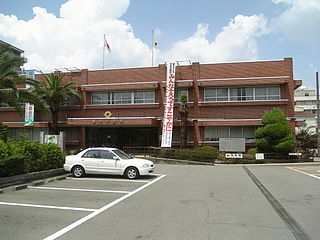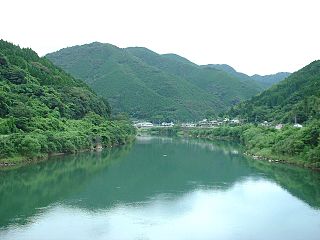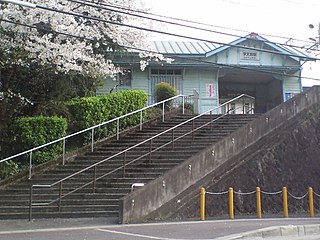
The Three Gorges Dam is a hydroelectric gravity dam that spans the Yangtze River by the town of Sandouping, in Yiling District, Yichang, Hubei province, central China, downstream of the Three Gorges. The Three Gorges Dam has been the world's largest power station in terms of installed capacity (22,500 MW) since 2012. The dam generates an average 95±20 TWh of electricity per year, depending on annual amount of precipitation in the river basin. After the extensive monsoon rainfalls of 2020, the dam's annual production nearly reached 112 TWh, breaking the previous world record of ~103 TWh set by Itaipu Dam in 2016.

Hashimoto is a city located in Wakayama Prefecture, Japan. As of 30 November 2021, the city had an estimated population of 61,063 in 27392 households and a population density of 470 persons per km². The total area of the city is 130.55 square kilometres (50.41 sq mi).
Mizuage was a ceremony undergone by apprentice oiran and some maiko as part of their coming of age ceremony and graduation.

The Mangla Dam is a multipurpose dam situated on the Jhelum River in the Mirpur District of Azad Jammu and Kashmir, Pakistan. It is the sixth-largest dam in the world. The village of Mangla, which sits at the mouth of the dam, serves as its namesake. In November 1961, the project's selected contractors were revealed; it was announced that Binnie & Partners, a British engineering firm, was going to serve as the lead designers, engineers, and inspectors for the construction of the dam. The project was undertaken by a consortium known as the Mangla Dam Contractors, which consisted of eight American construction firms sponsored by the Guy F. Atkinson Company based in South San Francisco, California.

The Kuma River is a river in Kumamoto Prefecture, central Western part of Kyūshū, Japan. It is sometimes referred as Kumagawa River. It is the longest river in Kyushu, with the length of 115 km long and has a drainage area of 1,880 km2 (730 sq mi). The tidal flat of the Kuma River estuary is approximately 1000 hectares.
Kamikaze is a Japanese manga series written and illustrated by Satoshi Shiki, published in Kodansha's Monthly Afternoon magazine from 1997 to 2003.

Malampuzha Dam is the largest dam and reservoirs in Kerala, located near Palakkad, in the state of Kerala in South India, built post independence by the then Madras state. Situated in the scenic hills of the Western Ghats in the background it is a combination of a masonry dam with a length of 1,849 metres and an earthen dam with a length of 220 metres making it the longest dam in the state. The dam is 355 feet high and crosses the Malampuzha River, a tributary of Bharathappuzha, Kerala's second longest river. There is a network of two canal systems that serve the dam's reservoir of 42,090 hectares.

The Shō River has its source in Mount Eboshi in the Shōkawa-chō area of Takayama, Gifu Prefecture, Japan. After flowing for 115 km (71 mi) through the northern part of Gifu Prefecture and the western part of Toyama Prefecture, it empties into Toyama Bay.

Kamuro Station is a passenger railway station in the city of Hashimoto, Wakayama Prefecture, Japan, operated by the private railway company Nankai Electric Railway.

Agigawa Dam is a dam built on the Kisogawa River system, located in the Higashino section of Ena City, in Gifu Prefecture, Japan.

Eishōsai Chōki, also known as Momokawa Chōki, was a designer of ukiyo-e style Japanese woodblock prints who was active from about 1786 to 1808. He, along with Utamaro, was a pupil of Toriyama Sekien (1712–1788). Chōki is best known for his pictures of beautiful slender women (bijin-ga), often with atmospheric backgrounds.

The Samanala Dam is a dam primarily used for hydroelectric power generation in Sri Lanka. Commissioned in 1992, the Samanalawewa Project is the third-largest hydroelectric scheme in the country, producing 405 GWh of energy annually. It was built with financial support from Japan and the United Kingdom. It is notable for a large leak on its right bank. Power production continues as planned despite the leakage, and the water from the leak now provides two thirds of the water issued by the reservoir for agriculture in downstream areas.

The Gōnokawa River is a river that runs through Hiroshima and Shimane prefectures in Japan. It is the largest river in the Chūgoku region. It is also called the Gōgawa River and, in Hiroshima, the Enokawa River.

The Natori River is a river located in central Miyagi prefecture, in the Tōhoku region of northern Japan. It starts at Mount Kamuro in the Ōu Mountains and flows in an easterly direction through the cities of Natori and Sendai. The river's headwaters start in the Zao Mountain range, it flows through the Sendai Plain and ends by draining into Sendai Bay. The river's estuary is located on Japan's east coast, and faces the Pacific Ocean. The river's flow is the greatest during the snow melt season from March to April, the rainy season from June to July and during the typhoon season from September to October. The river's length is 55 km, and its tributaries are the Hirose, Masuda and Goishi Rivers. The Natori provides water for 1 million people in the city of Sendai.

A volcanic crater lake is a lake in a crater that was formed from explosive activity or collapse during a volcanic eruption.

Cue! is a Japanese mobile game produced by Liber Entertainment. It launched on iOS and Android systems on October 25, 2019. The game is a simulation game where players can train up-and-coming voice actors. An anime television series adaptation by Yumeta Company and Graphinica premiered in January 2022 on the Animeism programming block.

Kamurochō is a fictional district of Tokyo from Sega's Ryū ga Gotoku media franchise, known internationally as Yakuza. It is modelled after Kabukichō, Tokyo's renowned red-light district and entertainment precinct situated in Shinjuku ward. Like its real world counterpart, there are many retail shops, izakaya, restaurants, and mizu shōbai establishments like host and hostess clubs, soaplands, and nightclubs within the district. Kamurochō has appeared as the primary setting in all Yakuza main series titles and several spin-off games, as well as adaptations of the franchise in other media.
Kumanogawa Dam is a gravity dam located in Toyama prefecture in Japan. The dam is used for flood control, water supply and power production. The catchment area of the dam is 39.8 km2. The dam impounds about 34 ha of land when full and can store 9100 thousand cubic meters of water. The construction of the dam was started on 1970 and completed in 1984.
Unazuki Dam is a gravity dam located in Toyama prefecture in Japan. The dam is used for flood control, water supply and power production. The catchment area of the dam is 617.5 km2. The dam impounds about 88 ha of land when full and can store 24700 thousand cubic meters of water. The construction of the dam was started on 1974 and completed in 2000.















